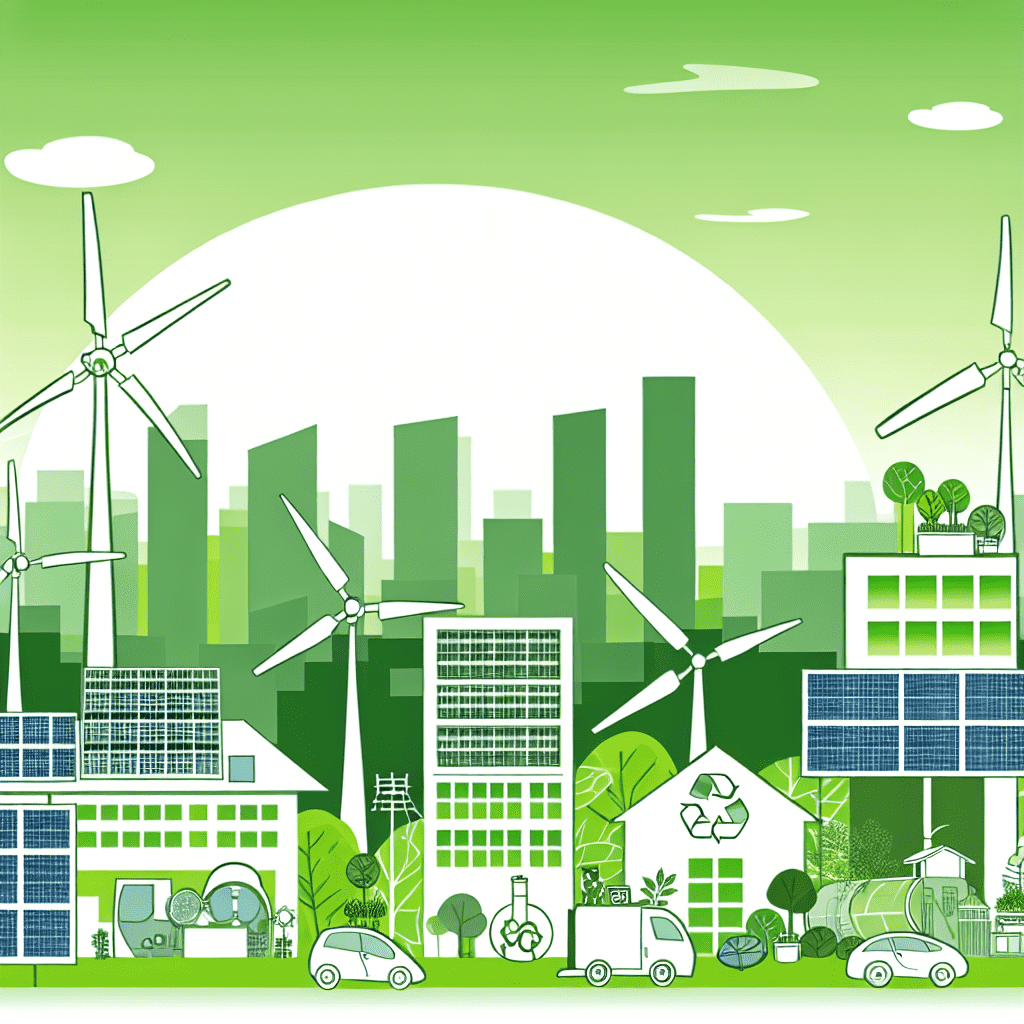
The year 2025 finds us at a critical juncture. Climate change is no longer a distant threat but a present reality, demanding immediate and comprehensive action. This urgency has fueled what many are calling the Green Tech Revolution – a surge of innovative technologies aimed at minimizing our environmental impact and fostering a more sustainable future. From renewable energy sources to advanced materials and circular economy solutions, green technologies are transforming industries and reshaping our daily lives. Understanding these innovations, their potential, and their practical implications is crucial for individuals, businesses, and policymakers alike. This guide provides a comprehensive overview of the Green Tech Revolution, offering insights into its key areas, practical guidance for implementation, and long-term considerations for a sustainable tomorrow.
This guide delves into the key aspects of navigating the green tech landscape in 2025.
Understanding the Scope of Green Tech
Green technology encompasses a vast range of innovations designed to address environmental challenges. These technologies span various sectors, including energy, transportation, agriculture, manufacturing, and waste management. Understanding the breadth of green tech is the first step towards identifying solutions that align with specific needs and goals.
- Renewable Energy: Solar, wind, hydro, geothermal, and biomass energy sources are replacing fossil fuels, reducing greenhouse gas emissions and promoting energy independence. Advancements in energy storage technologies, such as batteries and pumped hydro, are further enhancing the reliability and accessibility of renewable energy.
- Sustainable Transportation: Electric vehicles (EVs), hydrogen fuel cell vehicles, and biofuels are transforming the transportation sector, reducing air pollution and carbon emissions. The development of autonomous vehicles and smart transportation systems promises to further optimize energy efficiency and reduce traffic congestion.
- Precision Agriculture: Technologies like drones, sensors, and data analytics are optimizing agricultural practices, reducing water consumption, minimizing fertilizer use, and improving crop yields. Vertical farming and controlled environment agriculture are also gaining traction, enabling year-round food production in urban areas.
- Green Building and Construction: Sustainable building materials, energy-efficient designs, and smart building technologies are reducing the environmental impact of the built environment. Green roofs, solar panels, and rainwater harvesting systems are becoming increasingly common features of modern buildings.
- Waste Management and Circular Economy: Innovative waste management technologies, such as advanced recycling processes, waste-to-energy conversion, and composting, are minimizing landfill waste and recovering valuable resources. The circular economy promotes the design of products and systems that minimize waste and maximize resource utilization.
Practical Guidance: Evaluating and Selecting Green Tech Solutions
Choosing the right green tech solution requires careful evaluation and consideration of various factors. Here's a practical guide to help you navigate the selection process:
- Define Your Objectives: Clearly identify your environmental goals and the specific challenges you aim to address. Are you looking to reduce your carbon footprint, conserve water, minimize waste, or improve energy efficiency?
- Assess Your Needs: Evaluate your current operations, resource consumption, and environmental impact. Conduct a thorough energy audit, water audit, or waste audit to identify areas for improvement.
- Research Available Technologies: Explore the range of green tech solutions that align with your objectives and needs. Research their performance, cost, and environmental benefits. Consult with industry experts, read case studies, and attend relevant conferences and webinars.
- Evaluate Cost-Effectiveness: Compare the upfront costs, operating costs, and long-term savings of different green tech solutions. Consider factors such as energy savings, water savings, waste reduction, and potential revenue generation. Perform a cost-benefit analysis to determine the return on investment.
- Assess Environmental Impact: Evaluate the environmental impact of different green tech solutions, considering factors such as greenhouse gas emissions, water pollution, air pollution, and resource depletion. Look for technologies that minimize their environmental footprint throughout their lifecycle.
- Consider Scalability and Adaptability: Choose green tech solutions that can be scaled and adapted to meet your future needs. Consider the potential for future expansion, integration with other systems, and compatibility with evolving technologies.
- Check for Certifications and Standards: Look for green tech solutions that have been certified by reputable organizations and meet relevant environmental standards. Certifications such as Energy Star, LEED, and Cradle to Cradle provide assurance of environmental performance and sustainability.
- Seek Expert Advice: Consult with green tech consultants, engineers, and other experts to get unbiased advice and guidance. They can help you evaluate your options, design optimal solutions, and ensure successful implementation.
Long-Term Considerations: Maintenance, Responsibilities, and Ownership Costs
Implementing green tech solutions is not a one-time investment but a long-term commitment. It's crucial to consider the ongoing maintenance requirements, recurring responsibilities, and associated ownership costs to ensure the long-term success and sustainability of your green tech initiatives.
- Maintenance Requirements: Most green tech solutions require regular maintenance to ensure optimal performance and longevity. This may include routine inspections, cleaning, repairs, and replacements. Develop a comprehensive maintenance plan and budget to ensure that your green tech assets are properly maintained.
- Recurring Responsibilities: Implementing green tech solutions often entails ongoing responsibilities, such as monitoring performance, collecting data, reporting environmental metrics, and complying with regulations. Designate personnel or hire consultants to manage these responsibilities effectively.
- Ownership Costs: In addition to upfront costs, consider the ongoing ownership costs associated with green tech solutions. These may include energy costs, water costs, waste disposal costs, insurance costs, and property taxes. Factor these costs into your long-term financial planning.
- Lifecycle Assessment: Conduct a lifecycle assessment to evaluate the environmental impact and economic costs of green tech solutions throughout their entire lifecycle, from manufacturing to disposal. This will help you make informed decisions and minimize the overall environmental footprint of your green tech initiatives.
- Training and Education: Provide training and education to your employees and stakeholders on the operation, maintenance, and benefits of green tech solutions. This will ensure that they are properly utilized and contribute to your sustainability goals.
- Monitoring and Evaluation: Regularly monitor and evaluate the performance of your green tech solutions to ensure that they are meeting your objectives. Track key metrics such as energy savings, water savings, waste reduction, and greenhouse gas emissions. Use this data to identify areas for improvement and optimize your green tech strategies.
The Role of Policy and Regulation
Government policies and regulations play a crucial role in driving the adoption of green technologies. Incentives such as tax credits, subsidies, and grants can encourage businesses and individuals to invest in green tech solutions. Regulations such as carbon pricing, emissions standards, and renewable energy mandates can create a level playing field and accelerate the transition to a sustainable economy. Staying informed about relevant policies and regulations is essential for navigating the green tech landscape and maximizing the benefits of green tech investments.
Examples of Green Tech in Action
Here are some concrete examples of how green technologies are being implemented across various sectors:
- Solar-Powered Microgrids: Communities in remote areas are using solar-powered microgrids to provide reliable and affordable electricity, reducing their reliance on fossil fuels and improving their quality of life.
- Electric Bus Fleets: Cities are replacing their diesel bus fleets with electric buses, reducing air pollution and noise pollution in urban areas.
- Precision Irrigation Systems: Farmers are using precision irrigation systems to optimize water use and improve crop yields, conserving water resources and reducing the need for fertilizers.
- Green Building Materials: Construction companies are using green building materials such as bamboo, recycled concrete, and reclaimed wood to reduce the environmental impact of their projects.
- Waste-to-Energy Plants: Municipalities are building waste-to-energy plants to convert waste into electricity and heat, reducing landfill waste and generating clean energy.
Data and Trends in Green Tech
The green tech market is experiencing rapid growth, driven by increasing environmental awareness, government support, and technological advancements. According to a report by BloombergNEF, global investment in renewable energy reached a record high of $366 billion in 2021. The electric vehicle market is also booming, with global EV sales expected to reach 6.4 million units in 2021, a 98% increase from the previous year. These trends indicate that green tech is becoming increasingly mainstream and is poised to play a central role in shaping a sustainable future.
| Green Tech Sector | Global Market Size (2023) | Projected Growth Rate (2023-2030) | Key Drivers |
|---|---|---|---|
| Renewable Energy | $1.1 Trillion | 8.9% CAGR | Government incentives, declining costs, increasing energy demand |
| Electric Vehicles | $800 Billion | 21.7% CAGR | Government regulations, battery technology advancements, consumer demand |
| Green Building | $450 Billion | 9.8% CAGR | Sustainability awareness, energy efficiency mandates, LEED certification |
| Water Treatment Technologies | $180 Billion | 6.5% CAGR | Water scarcity, stricter regulations, technological innovations |
| Sustainable Agriculture | $120 Billion | 11.2% CAGR | Food security concerns, environmental impacts of conventional agriculture, precision farming |
The Future of Green Tech
The Green Tech Revolution is just beginning. As technologies continue to advance and costs continue to decline, green tech solutions will become even more accessible and affordable. Emerging technologies such as carbon capture and storage, hydrogen energy, and advanced materials hold immense potential for further reducing our environmental impact and creating a truly sustainable future. By embracing green tech innovations and working together, we can build a cleaner, healthier, and more prosperous world for generations to come.
FAQ (Frequently Asked Questions)
- Q: What are the main challenges to wider adoption of green technologies?
- A: Key challenges include high upfront costs, lack of public awareness, regulatory hurdles, and resistance from established industries. Overcoming these challenges requires government support, technological advancements, and increased public education.
- Q: How can small businesses benefit from investing in green tech?
- A: Small businesses can benefit from reduced operating costs (e.g., energy savings), improved brand image, access to government incentives, and increased customer loyalty. Green initiatives can also attract and retain talent.
- Q: What is the role of individual consumers in promoting green tech?
- A: Individual consumers can support green tech by purchasing energy-efficient appliances, driving electric vehicles, adopting sustainable lifestyles, and advocating for environmentally friendly policies. Consumer demand can drive innovation and accelerate the adoption of green technologies.
- Q: What are some emerging green technologies to watch out for?
- A: Emerging green technologies include carbon capture and storage (CCS), hydrogen fuel cells, advanced battery technologies, vertical farming, and bio-based materials. These technologies hold significant promise for addressing climate change and promoting sustainability.
- Q: How can I measure the environmental impact of my green tech investments?
- A: You can measure the environmental impact of your green tech investments by tracking key metrics such as carbon footprint, water consumption, waste generation, and energy usage. There are also various tools and methodologies available for conducting lifecycle assessments and environmental impact analyses.
Disclaimer: This information is for informational purposes only and does not constitute professional advice. Consult with qualified experts before making any decisions related to green technology investments or implementation. Prices and market data are accurate as of 2025.
Sources:
- International Renewable Energy Agency (IRENA)
- U.S. Environmental Protection Agency (EPA)
- BloombergNEF (BNEF)
- International Energy Agency (IEA)
The Green Tech Revolution presents a transformative opportunity to address environmental challenges and build a sustainable future. By understanding the scope of green tech, evaluating available solutions, considering long-term implications, and staying informed about policies and trends, individuals, businesses, and policymakers can effectively navigate the green tech landscape and contribute to a cleaner, healthier, and more prosperous world.
- Key Insight: Green tech encompasses a wide range of innovations across various sectors, offering solutions to address climate change, resource depletion, and pollution.
- Essential Tip: Conduct thorough research and evaluation before investing in green tech solutions, considering factors such as cost-effectiveness, environmental impact, and scalability.
- Helpful Takeaway: Long-term success with green tech requires ongoing maintenance, monitoring, and adaptation, as well as a commitment to continuous improvement.




